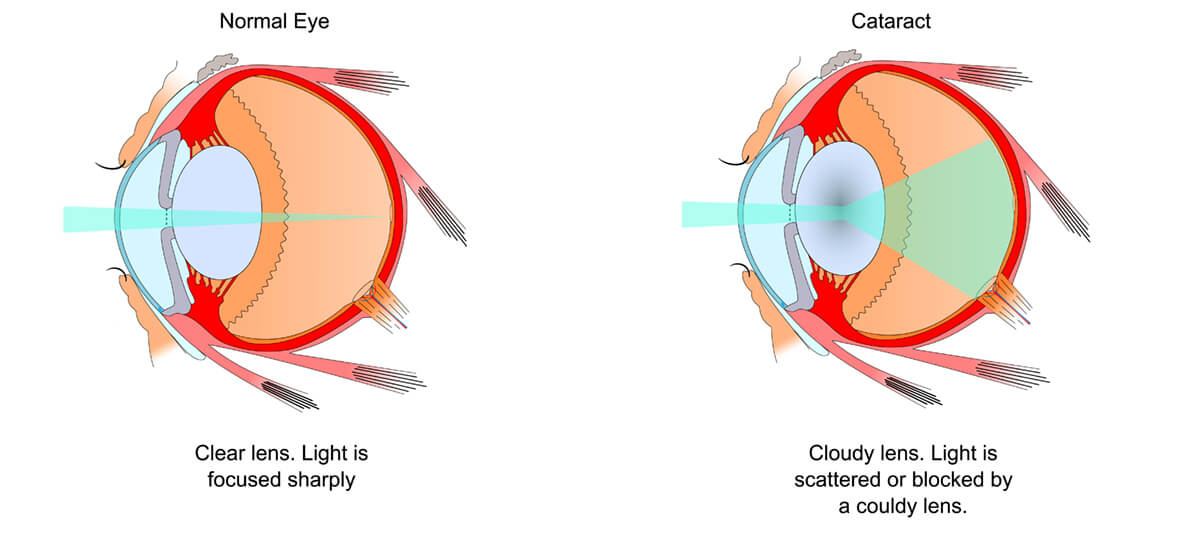Cataracts
A Cataract is caused by cloudiness that occurs in the naturally clear lens of the eye. The lens sits behind the iris (or the colored part of the eye). A cataract causes vision to become blurry or dimmer over time. Patients may experience dulling of colors and/or glare and halos when driving at night.
Click Image To Enlarge
At Eye Consultants of North Dakota, we are committed to providing you with the highest quality surgical care to remove your cataracts and improve your vision, so that you can get back to the activities you enjoy. We offer the most advanced diagnostic and premium implant options and will walk with you each step of the way. Prior to cataract surgery, we will schedule a clinic consultation with you. During your clinical consultation with one of our surgeons, we will examine your eyes, complete several tests and review all of the options for lens implants and cataract surgery. Please plan to spend up to 2 hours at our clinic. If you wear soft contact lenses, please do not wear your contacts for 2 weeks prior to this visit. If you wear rigid gas permeable or “hard” lenses, please contact our office for further instructions. Your pupils will be dilated for this exam, so we would suggest you have someone drive you to and from this appointment.
Lens Implants

Monofocal Implants
These advanced lenses/implants are the most common implant used in cataract surgery and are covered by insurance. They will focus the vision to either distance, intermediate, or near, but will not correct astigmatism and most patients will require glasses for reading after surgery. Some patients may request monovision where one eye is targeted for distance vision and the other eye is targeted for reading vision. These patients will typically be able to get by without glasses for most tasks, but may still require glasses for night time driving or reading for prolonged periods of time.
Multifocal Implants
These advanced technology lenses/implants are designed to provide distance, intermediate, and near vision for each eye. In other words, each eye independently will have very good distance, intermediate, and near vision, but the vision will be even better when both eyes have the multifocal implant and can work together. There are limitations to these implants and some patients will experience halos with lights and glare with night time driving. Not all patients are a candidate for this implant due to other eye problems that may exist, which would be discussed at your cataract evaluation prior to surgery. There is also an additional out of pocket cost for these implants.
Toric Implants
For patients who have astigmatism, the Toric implant is another advanced technology lens/implant available to correct this at the time of cataract surgery. It works very well to provide excellent distance or near vision for those patients who are candidates for this implant. There are implants that will correct the astigmatism and provide distance, intermediate, and near vision for patients that are candidates for this implant. Like the Multifocal implants, there is an additional out of pocket cost for the Toric Implant.
Extended Depth of Focus Lens Implants
Extended depth of focus (EDOF) lens implants create a single elongated focal point to enhance your range of vision. Patients have a broader range of vision with an extended depth of focus lens than they would with a monofocal lens, which can only correct for one distance. With an extended depth of focus lens, you can see clearly far away and at intermediate distances.
An extended depth of focus lens implant will provide you with functional intermediate (arm’s length) vision, but you’ll still need to use reading glasses to complete tasks requiring fine focus or seeing things up close. An extended depth of focus lens implant will make it easier to use a computer at home, look at your smartphone, or see your car’s dashboard, as it will give you some flexibility with your intermediate vision.
You’ll experience high-quality image quality when looking at things at a distance with an extended depth of focus lens. You’ll also have improved low-light image contrast, making driving safer at night, and making it easier to see things in the distance, like traffic lights.
An extended depth of focus lens corrects presbyopia and astigmatism during cataract surgery if a toric model is chosen for patients with astigmatism. Choosing an extended depth of focus lens implant can reduce your dependence on glasses and contacts after cataract surgery, making it an excellent choice if you’re physically active.
Because an extended depth of focus lens only creates one single-elongated focal point to enhance your depth of focus, visual aberrations like halos and glare around lights are significantly reduced. These are some more common symptoms that patients with multifocal lenses often experience.
Because an extended depth of focus lens implant is a premium lens, it has an additional out-of-pocket cost associated with it. Talk to your eye doctor at Eye Consultants of North Dakota in Fargo, ND, if you’re interested in learning more about this IOL or other lens implants we offer to patients.




